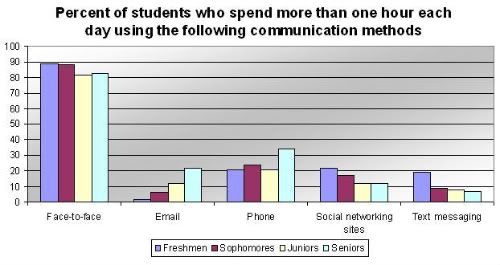How Does Technology Impact Young Adults' Writing Habits?
Posted in The Gnovis Blog
At the Pew Internet and American Life Project, we recently published a report titled Writing, Technology and Teens, which considered the impact of informal writing styles, as commonly found in the infinite number of shorthand conversations young people have each day over text messaging and IM. The primary question we wanted to answer with this research was if these informal writing styles, which make liberal use of writing shortcuts such as acronyms (e.g., LOL, ROFL, BRB, etc.); abbreviations (e.g., "cu2nite", meaning "see you tonight"); and emoticons, such as the recently-turned-10-years-old smiley face, had any effects on teens’ more formal writing, such as what was required from them in a school environment.
As Nicole recently wrote, the results from this research reveal that while most teens do not consider these forms of interaction as "writing," the habits developed in quick messaging conversations do bleed into their more formal, school-based writing. Since I considered the communication habits of college students for my master’s thesis work, I thought it might be interesting to look at the questions posed in our teens’ research in light of my data on a slightly older crowd. Below is a cross-post that I have also published on Pew’s website; the original post can be found here.
********
For my master’s thesis at Georgetown University, I was interested in
how 21st century communication technologies are changing the ways in
which people interact with members of their social networks.
Specifically, I focused my research on how Facebook is altering the
methods users employ to build and maintain a network of friends. This
research was facilitated by a survey of 644 Georgetown undergraduates
on their uses of various communication technologies, and especially the
internet, in keeping connected with others.
I recently began thinking of my research in light of Pew’s recent Writing, Technology and Teens
report, and saw several interesting connections between the two. Both
studies focus on digital natives, or those users who have had access to
many of these newer communication technologies since a young age: Pew’s
report looks at 12-17 year olds, while my research was limited to
college undergraduates ages 18-25. Furthermore, both studies consider
the implications of technology on communication. Therefore, the
question that arose in my mind was, do the trends we found in our Pew
report among younger teens also apply to young adults?
In my survey, I asked respondents about the amount of time they
spend on an average day using a variety of communication methods to
keep in touch with friends, family and associates. A relationship
between year in school and technology use quickly emerged, with
upperclassmen being significantly more likely to spend more than one
hour per day using "older" communication technologies such as the phone
and email. Conversely, freshmen were twice as likely as upperclassmen
to spend more than an hour each day on social networking sites to
communicate and more than twice as likely to be spending that much time
text messaging on an average day. See the chart below for a breakout of
communication usage results from my survey across students’ year in
school.

A number of possible conclusions could be drawn from these
findings. Older students may be using formal communication methods more
because they are looking beyond college and working on establishing a
more professional online network and image. Younger students may be
spending more time on newer technologies because they have, for all
intents and purposes, grown up with them, and see these newer methods
of communication as both quicker and easier ways of interacting. When
Facebook launched in 2004, for example, current college seniors were
just finishing up their high school years. Current college freshmen,
however, had just begun high school; at this age, text-based gossip and
IMing are a virtual institution. Consider, for example, Verizon’s
recent series of commercials centering on young teens and their text
messaging habits.
But what does this finding have to do with writing? The younger
respondents in my survey tend to spend more time each day interacting
with others via communication methods that encourage text shortcuts
such as abbreviations, acronyms and emoticons. Therefore, these ways of
typing — being more ingrained in younger users’ minds — are probably
more likely to bleed over into their more formal writing than among
upperclassmen. In the college environment, however, these students are
unlikely to find sympathy from their professors if such informal
writing styles appear in their midterms and exams. Likewise, these
students may have learned in high school about separating their formal
and informal writing and do not allow the informal styles discussed in
the Pew report to appear in their collegiate writing.
One of the most important things I have learned from my master’s thesis research, and something I believe the Writing
report echoes, is that we now stand at a turning point in communication
technology. Longitudinal research should be conducted in future years
to see if the results of these two studies are merely a reflection of a
current fad or if the way we write and interact with the different
types of people in our social networks is evolving.
